Crystalinks
The Holographic Universe
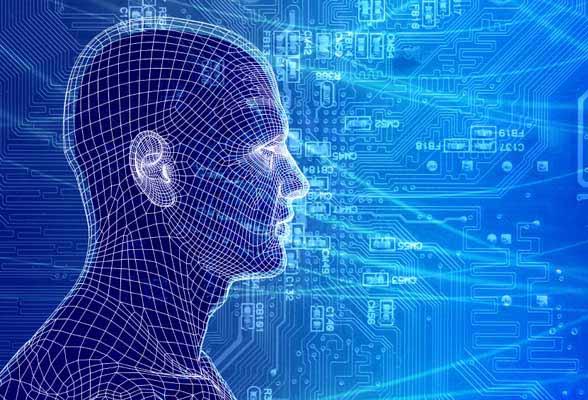
The theory that reality, as we consciously experience it, is not real, goes back to ancient indigenous people who believed we exist in a dream or illusion. In our current timeline, we refer to the matrix, grids, virtual reality, simulation and hologram. Today many physicists are researching the concept of the universe as a hologram.
The universe is a consciousness hologram. Reality is projected illusion within the hologram. It is a virtual experiment created in linear time to study emotions. Our hologram is composed of grids created by a source consciousness brought into awareness by electromagnetic energy at the physical level. The hologram is created and linked through a web, or grid matrixes based on the patterns of Sacred Geometry. The hologram had a beginning and it has an end, as consciousness evolves in the alchemy of time. As the grids collapse, everything within the hologram will end, helping to understand what is going on in the world today.
In media we find films, television shows, books, and games, based on the concept of reality as a hologram. Among the more easily recognized are The Matrix (Illusion), The Thirteenth Floor (Simulation), Inception (Dream), the Holodeck (Grids) in the TV series Star Trek, Second Life an Internet game, and The Holographic Universe a 1991 book by Michael Talbot (see his theories below).
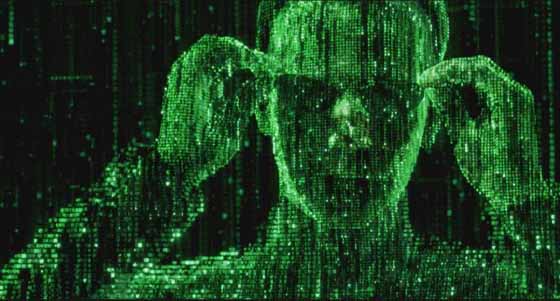
Is it real? Physicists propose method to determine if the universe is a simulation PhysOrg - October 12, 2012
A common theme of science fiction movies and books is the idea that we're all living in a simulated universe - that nothing is actually real. The team's idea is based on work being done by other scientists who are actively engaged in trying to create simulations of our universe, at least as we understand it. Thus far, such work has shown that to create a simulation of reality, there has to be a three dimensional framework to represent real world objects and processes. With computerized simulations, it's necessary to create a lattice to account for the distances between virtual objects and to simulate the progression of time. The German team suggests such a lattice could be created based on quantum chromodynamics - theories that describe the nuclear forces that bind subatomic particles.
Physicists say there may be a way to prove that we live in a computer simulation io9.com - October 12, 2012
Back in 2003, Oxford professor Nick Bostrom suggested that we may be living in a computer simulation. In his paper, Bostrom offered very little science to support his hypothesis - though he did calculate the computational requirements needed to pull of such a feat. And indeed, a philosophical claim is one thing, actually proving it is quite another. But now, a team of physicists say proof might be possible, and that it's a matter of finding a cosmological signature that would serve as the proverbial Red Pill from the Matrix. And they think they know what it is. According to Silas Beane and his team at the University of Bonn in Germany, a simulation of the universe should still have constraints, no matter how powerful. These limitations, they argue, would be observed by the people within the simulation as a kind of constraint on physical processes.
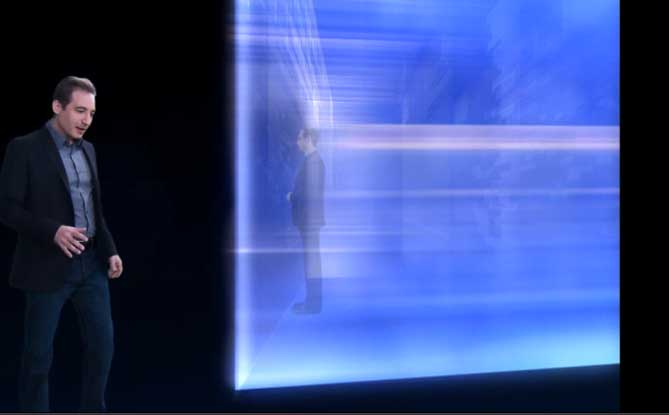
Fabric of the Cosmos - Reality as a Hologram
NOVA Documentary - PBS 11/2/11
How a Holographic Universe Emerged From Fight With Stephen Hawking
Wired - August 1, 2011
The proponents of string theory seem to think they can provide a more elegant description of the Universe by adding additional dimensions. But some other theoreticians think theyÕve found a way to view the Universe as having one less dimension. The work sprung out of a long argument with Stephen Hawking about the nature of black holes, which was eventually solved by the realization that the event horizon could act as a hologram, preserving information about the material thatÕs gotten sucked inside. The same sort of math, it turns out, can actually describe any point in the Universe, meaning that the entire content Universe can be viewed as a giant hologram, one that resides on the surface of whatever two-dimensional shape will enclose it. When it comes to the basic idea - the Universe can be described using a hologram ...
Does Quantum Theory Explain Consciousness?
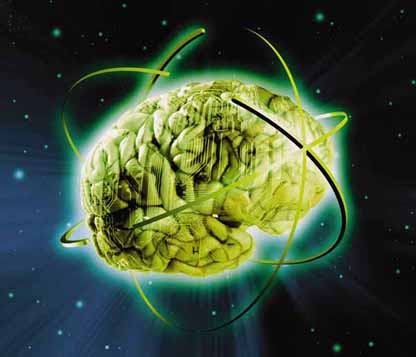
Discovery - May 27, 2011
Consciousness: How do you go about explaining that? Indeed, many scientists are currently studying what happens in the brain and how the mind relates to the outside world, but quantifying what gives us consciousness is proving to be a rather tough nut to crack. Is there some supernatural influence? Is it purely biological? Or is there something else, something more... physicsy? Don't you think our consciousness might be explained by the Large Hadron Collider which is probing states of matter that existed immediately after the Big Bang, so it's bound to throw up some new physics -- don't you reckon it might uncover some sort of particle, or energy, that might explain our connectivity with the Universe?
Possibly inspired by the crazy science butchered in the TV series FlashForward - in which everyone on the planet gets knocked out for 2 minutes and 17 seconds, having visions 6 months into the future, after an experiment apparently went awry in a particle accelerator - my friend was quick to point out that quantum physics, by its nature, is weird, and consciousness is, well, weird, so there must be some connection. While this may be attractive -- after all, quantum mechanics brought us Schrodinger's-very-confused-dead-or-alive-(or both)-Cat -- there is a fundamental flaw in this logic. As Brooks mentions in his article, "strange quantum effects don't fit in with our everyday experience of the world, they have been invoked to resolve myriad things we don't yet understand, such as supernatural phenomena."
Are We Living in a Hologram?
Do you ever have days when you question reality? One scientist has gone a step further; he is currently building an experiment that will hopefully answer whether or not we all exist as a result of a universal hologram. You're not alone. The holographic universe hypothesis is steeped in complex mathematics and descriptions that belong in hard science fiction novels. Fermilab particle physicist Craig Hogan renewed interest in the holographic universe concept after investigating the noise measured by a gravitational wave detector called GEO600 in Germany. Before we can understand what this "noise" is (let alone why the Universe could be a hologram), we need to understand how gravitational wave detectors work.
Consciousness Crystalinks
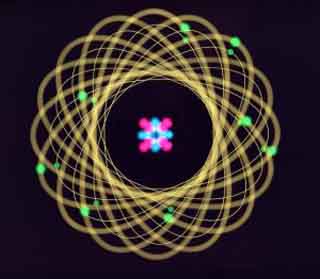
Reality: A Mere Illusion
Epoch Times - December 15, 2009
According to recent research in the field of quantum physics, all of what we know as matter - the solid cement of what appears to be what our reality is composed of - could be nothing more than quantum fluctuations in the middle of the empty universe.
Reality: A Mere Illusion - Part 2
Epoch Times - December 20, 2009
You and I, Only Holograms
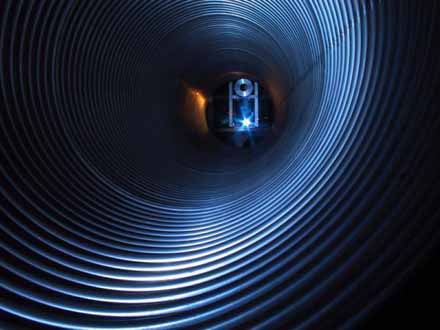
Holographic Universe: Discovery Could Herald New Era In Fundamental Physics
Science Daily - February 5, 2009
Cardiff University researchers, who are part of a British-German team searching the depths of space to study gravitational waves, may have stumbled on one of the most important discoveries in physics, according to an American physicist. Craig Hogan, a physicist at Fermilab Centre for Particle Astrophysics in Illinois is convinced that he has found proof in the data of the gravitational wave detector GEO600 of a holographic Universe Ð and that his ideas could explain mysterious noise in the detector data that has not been explained so far. The British-German team behind the GEO600, which includes scientists from the School of Physics and Astronomy's Gravitational Physics Group, will now carry out new experiments in the coming months to yield more evidence about Craig Hogan's assumptions. If proved correct, it could help in the quest to bring together quantum mechanics and Einstein's theory of gravity.
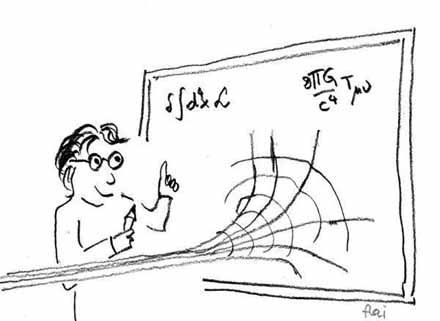
How Many Dimensions In The Holographic Universe?
Science Daily - February 9, 2009
Viennese scientists are trying to understand the mysteries of the holographic principle: How many dimensions are there in our universe? Some of the world's brightest minds are carrying out research in this area -- and still have not succeeded so far in creating a unified theory of quantum gravitation is often considered to be the ÒHoly GrailÓ of modern science.
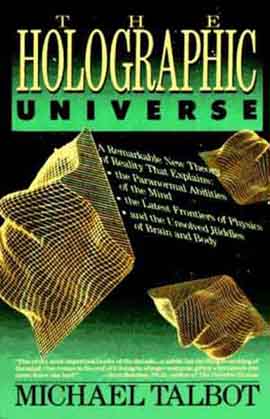
 Michael Talbot (1953-1992), was the author of several books on holograms and quantum mechanics,and their relationship to ancient mysticism and the theoretical models of reality. Talbot explored the works of physicist David Bohm and neurophysiologist Karl Pribram, who independently reached the conclusion that the universe operates on a holographic model. In Talbot's book, The Holographic Universe, Talbot also arrives at this conclusion and maintains that the holographic model might also explain numerous paranormal and unusual phenomena as well as offer a basis for mystical experiences.
Michael Talbot (1953-1992), was the author of several books on holograms and quantum mechanics,and their relationship to ancient mysticism and the theoretical models of reality. Talbot explored the works of physicist David Bohm and neurophysiologist Karl Pribram, who independently reached the conclusion that the universe operates on a holographic model. In Talbot's book, The Holographic Universe, Talbot also arrives at this conclusion and maintains that the holographic model might also explain numerous paranormal and unusual phenomena as well as offer a basis for mystical experiences.
In 1982, at the University of Paris a research team led by physicist Alain Aspect performed what may turn out to be one of the most important experiments of the 20th century. Aspect's experiment was related to the EPR Experiment, a consciousness experiment which had been devised by Albert Einstein, and his colleagues, Poldlsky and Rosen, in order to disprove Quantum Mechanics on the basis of the Pauli Exclusion Principlecontradicting Special Relativity.
Aspect and his team discovered that under certain circumstances subatomic particles such as electrons are able to instantaneously communicate with each other regardless of the distance separating them. It doesn't matter whether they are 10 feet or 10 billion miles apart. Somehow each particle always seemed to know what the other was doing. This feat violates Einstein's long-held tenet that no communication can travel faster than the speed of light which is tantamount to breaking the time barrier. This daunting prospect has caused some physicists to try to come up with elaborate ways to explain away Aspect's findings. But it has inspired others to offer even more radical explanations.
University of London physicist David Bohm, for example, believes Aspect's findings imply that objective reality does not exist, that despite its apparent solidity the universe is at heart a phantasm, a gigantic and splendidly detailed hologram. To understand why Bohm makes this startling assertion, one must first understand a little about holograms. A hologram is a three- dimensional photograph made with the aid of a laser. To make a hologram, the object to be photographed is first bathed in the light of a laser beam. Then a second laser beam is bounced off the reflected light of the first and the resulting interference pattern (the area where the two laser beams commingle) is captured on film.
When the film is developed, it looks like a meaningless swirl of light and dark lines. But as soon as the developed film is illuminated by another laser beam, a three-dimensional image of the original object appears. The three-dimensionality of such images is not the only remarkable characteristic of holograms. If a hologram of a rose is cut in half and then illuminated by a laser, each half will still be found to contain the entire image of the rose. Even if the halves are divided again, each snippet of film will always be found to contain a smaller but intact version of the original image. Unlike normal photographs, every part of a hologram contains all the information possessed by the whole.
The "whole in every part" nature of a hologram provides us with an entirely new way of understanding organization and order. For most of its history, Western science has labored under the bias that the best way to understand a physical phenomenon, whether a frog or an atom, is to dissect it and study its respective parts. A hologram teaches us that some things in the universe may not lend themselves to this approach. If we try to take apart something constructed holographically, we will not get the pieces of which it is made, we will only get smaller wholes.
This insight suggested to Bohm another way of understanding Aspect's discovery. Bohm believes the reason subatomic particles are able to remain in contact with one another regardless of the distance separating them is not because they are sending some sort of mysterious signal back and forth, but because their separateness is an illusion. He argues that at some deeper level of reality such particles are not individual entities, but are actually extensions of the same fundamental something.
This fundamental connectedness would correlate with The Fifth Element, and its mathematical proof of all aspects of the universe being energetically connected - Hal Puthoff's assertion in his work on Zero-Point Energy of all charges in the universe being connected and that further mass is in all likelihood an illusion as well -- and both of these modern day theories of physics being in accordance with ancient traditions and philosophies, which claim the same connectedness of the diverse parts of the universe.
To enable people to better visualize what he means, Bohm offers the following illustration. Imagine an aquarium containing a fish. Imagine also that you are unable to see the aquarium directly and your knowledge about it and what it contains comes from two television cameras, one directed at the aquarium's front and the other directed at its side. As you stare at the two television monitors, you might assume that the fish on each of the screens are separate entities. After all, because the cameras are set at different angles, each of the images will be slightly different. But as you continue to watch the two fish, you will eventually become aware that there is a certain relationship between them. When one turns, the other also makes a slightly different but corresponding turn; when one faces the front, the other always faces toward the side. If you remain unaware of the full scope of the situation, you might even conclude that the fish must be instantaneously communicating with one another, but this is clearly not the case. This, says Bohm, is precisely what is going on between the subatomic particles in Aspect's experiment.
According to Bohm, the apparent faster-than-light connection between subatomic particles is really telling us that there is a deeper level of reality we are not privy to, a more complex dimension beyond our own that is analogous to the aquarium. And, he adds, we view objects such as subatomic particles as separate from one another because we are seeing only a portion of their reality. Such particles are not separate "parts", but facets of a deeper and more underlying unity that is ultimately as holographic and indivisible as the previously mentioned rose. And since everything in physical reality is comprised of these "eidolons", the universe is itself a projection, a hologram.
In addition to its phantom-like nature, such a universe would possess other rather startling features. If the apparent separateness of subatomic particles is illusory, it means that at a deeper level of reality all things in the universe are infinitely interconnected. The electrons in a carbon atom in the human brain are connected to the subatomic particles that comprise every salmon that swims, every heart that beats, and every star that shimmers in the sky. Everything interpenetrates everything, and although human nature may seek to categorize and pigeonhole and subdivide, the various phenomena of the universe, all apportionments are of necessity artificial and all of nature is ultimately a seamless web.
Superhologram
In a holographic universe, even time and space could no longer be viewed as fundamentals. Because concepts such as location break down in a universe in which nothing is truly separate from anything else, time and three-dimensional space, like the images of the fish on the TV monitors, would also have to be viewed as projections of this deeper order. At its deeper level reality is a sort of superhologram in which the past, present, and future all exist simultaneously. This suggests that given the proper tools it might even be possible to someday reach into the superholographic level of reality and pluck out scenes from the long-forgotten past.
What else the superhologram contains is an open-ended question. Allowing, for the sake of argument, that the superhologram is the matrix that has given birth to everything in our universe, at the very least it contains every subatomic particle that has been or will be -- every configuration of matter and energy that is possible, from snowflakes to quasars, from bluu whales to gamma rays. It must be seen as a sort of cosmic storehouse of "All That Is."
Although Bohm concedes that we have no way of knowing what else might lie hidden in the superhologram, he does venture to say that we have no reason to assume it does not contain more. Or as he puts it, perhaps the superholographic level of reality is a "mere stage" beyond which lies "an infinity of further development".
Karl Pribram
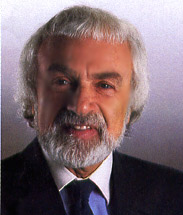
Bohm is not the only researcher who has found evidence that the universe is a hologram. Working independently in the field of brain research, Standford neurophysiologist Karl Pribram has also become persuaded of the holographic nature of reality. Pribram was drawn to the holographic model by the puzzle of how and where memories are stored in the brain. For decades numerous studies have shown that rather than being confined to a specific location, memories are dispersed throughout the brain.
In the 1960s Pribram encountered the concept of holography and realized he had found the explanation brain scientists had been looking for. Pribram believes memories are encoded not in neurons, or small groupings of neurons, but in patterns of nerve impulses that crisscross the entire brain in the same way that patterns of laser light interference crisscross the entire area of a piece of film containing a holographic image. In other words, Pribram believes the brain is itself a hologram.
Pribram's theory also explains how the human brain can store so many memories in so little space. It has been estimated that the human brain has the capacity to memorize something on the order of 10 billion bits of information during the average human lifetime.
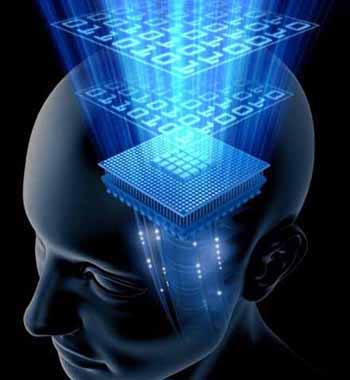
The brain is an electrochemical machine that stores information - binary code
One of the most amazing things about the human thinking process is that every piece of information seems instantly cross-correlated with every other piece of information - another feature intrinsic to the hologram. Because every portion of a hologram is infinitely interconnected with ever other portion, it is perhaps nature's supreme example of a cross-correlated system.
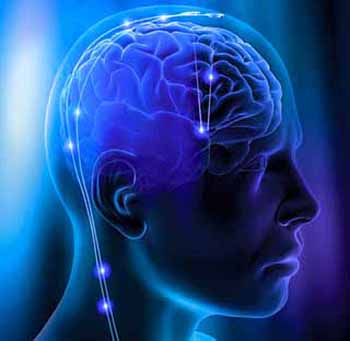
The storage of memory is not the only neurophysiological puzzle that becomes more tractable in light of Pribram's holographic model of the brain. Another is how the brain is able to translate the avalanche of frequencies it receives via the senses (light frequencies, sound frequencies, and so on) into the concrete world of our perceptions. Encoding and decoding frequencies is precisely what a hologram does best. Just as a hologram functions as a sort of lens, a translating device able to convert an apparently meaningless blur of frequencies into a coherent image, Pribram believes the brain also comprises a lens and uses holographic principles to mathematically convert the frequencies it receives through he senses into the inner world of our perceptions. An impressive body of evidence suggests that the brain uses holographic principles to perform its operations. Pribram's theory, in fact, has gained increasing support among neurophysiologists.
Holophonics
Argentinian-Italian researcher Hugo Zucarelli recently extended the holographic model into the world of acoustic phenomena. Puzzled by the fact that humans can locate the source of sounds without moving their heads, even if they only possess hearing in one ear, Zucarelli discovered that holographic principles can explain this ability. Zucarelli has also developed the technology of holophonic sound, a recording technique able to reproduce acoustic situations with an almost uncanny realism.
Pribram's belief that our brains mathematically construct "hard" reality by relying on input from a frequency domain has also received a good deal of experimental support. It has been found that each of our senses is sensitive to a much broader range of frequencies than was previously suspected. Researchers have discovered, for instance, that our visual systems are sensitive to sound frequencies, that our sense of smell is in part dependent on what are now called "cosmic frequencies", and that even the cells in our bodies are sensitive to a broad range of frequencies. Such findings suggest that it is only in the holographic domain of consciousness that such frequencies are sorted out and divided up into conventional perceptions.
But the most mind-boggling aspect of Pribram's holographic model of the brain is what happens when it is put together with Bohm's theory. For if the concreteness of the world is but a secondary reality and what is "there" is actually a holographic blur of frequencies, and if the brain is also a hologram and only selects some of the frequencies out of this blur and mathematically transforms them into sensory perceptions, what becomes of objective reality?
Put quite simply, it ceases to exist. As the religions of the East have long upheld, the material world is Maya, an illusion, and although we may think we are physical beings moving through a physical world, this too is an illusion. We are really "receivers" floating through a kaleidoscopic sea of frequency, and what we extract from this sea and transmogrify into physical reality is but one channel from many extracted out of the superhologram.
This striking new picture of reality, the synthesis of Bohm and Pribram's views, has come to be called the Holographic Paradigm, and although many scientists have greeted it with skepticism, it has galvanized others. A small but growing group of researchers believe it may be the most accurate model of reality science has arrived at thus far. More than that, some believe it may solve some mysteries that have never before been explainable by science and even establish the paranormal as a part of nature. Numerous researchers, including Bohm and Pribram, have noted that many para-psychological phenomena become much more understandable in terms of the holographicparadigm.
In a universe in which individual brains are actually indivisible portions of the greater hologram and everything is infinitely interconnected, telepathy may merely be the accessing of the holographic level. It is obviously much easier to understand how information can travel from the mind of individual 'A' to that of individual 'B' at a far distance point and helps to understand a number of unsolved puzzles in psychology.
Stansilov Grof

In particular, Stansilov Grof feels the holographic paradigm offers a model for understanding many of the baffling phenomena experienced by individuals during altered states of consciousness.
In the 1950s, while conducting research into the beliefs of LSD as a psychotherapeutic tool, Grof had one female patient who suddenly became convinced she had assumed the identity of a female of a species of prehistoric reptile. During the course of her hallucination, she not only gave a richly detailed description of what it felt like to be encapsulated in such a form, but noted that the portion of the male of the species anatomy was a patch of colored scales on the side of its head. What was startling to Grof was that although the woman had no prior knowledge about such things, a conversation with a zoologist later confirmed that in certain species of reptiles colored areas on the head do indeed play an important role as triggers of sexual arousal.
The womanÕs experience was not unique. During the course of his research, Grof encountered examples of patients regressing and identifying with virtually every species on the evolutionary tree (research findings which helped influence the man-into-ape scene in the movie, Altered States). Moreover, he found that such experiences frequently contained obscure zoological details which turned out to be accurate.
Regressions into the animal kingdom were not the only puzzling psychological phenomena Grof encountered. He also had patients who appeared to tap into some sort of collective or racial unconscious. Individuals with little or no education suddenly gave detailed descriptions of Zoroastrian funerary practices and scenes from Hindu mythology. In other categories of experience, individuals gave persuasive accounts of out-of-body journeys, of precognitive glimpses of the future, of regressions into apparent past-life incarnations.
In later research, Grof found the same range of phenomena manifested in therapy sessions which did not involve the use of drugs. Because the common element in such experiences appeared to be the transcending of an individualÕs consciousness beyond the usual boundaries of ego and/or limitations of space and time, Grof called such manifestations transpersonal experiences, and in the late '60s he helped found a branch of psychology called transpersonal psychology devoted entirely to their study. Although GrofÕs newly founded Association of Transpersonal Psychology garnered a rapidly growing group of like-minded professionals and has become a respected branch of psychology, for years neither Grof or any of his colleagues were able to offer a mechanism for explaining the bizarre psychological phenomena they were witnessing. But that has changed with the advent of the holographic paradigm.
As Grof noted, if the mind is actually part of a continuum, a labyrinth that is connected not only to every other mind that exists or has existed, but to every atom, organism, and region in the vastness of space and time itself, the fact that it is able to occasionally make forays into the labyrinth and have transpersonal experiences no longer seems so strange. Perhaps, in Creating Reality, we have already become - as in Star Trek, The Next Generation - a Q of the Continuum or we are part of a consciousness virtual reality experiment.
-
In his book Gifts of Unknown Things, biologist Lyall Watson describes his encounter with an Indonesian shaman woman who, by performing a ritual dance, was able to make an entire grove of trees instantly vanish into thin air. Watson relates that as he and another astonished onlooker continued to watch the woman, she caused the trees to reappear, then click off again and on again several times in succession. Although current scientific understanding is incapable of explaining such events, experiences like this become more tenable if hard reality is only a holographic projection.
Perhaps we agree on what is 'there' or 'not there' because what we call consensus reality is formulated and ratified at the level of the human unconscious at which all minds are infinitely interconnected. If this is true, it is the most profound implication of the holographic paradigm of all, for it means that experiences such as Watson's are not commonplace only because we have not programmed our minds with the beliefs that would make them so.
-
In a holographic universe there are no limits to the extent to which we can alter the fabric of reality.
What we perceive as reality is only a canvas waiting for us to draw upon it any picture we want. Anything is possible, from bending spoons with the power of the mind to events experienced by Carlos Castaneda during his encounters with the Yaqui brujo don Juan, for Magic is our birthright, no more or less miraculous than our ability to compute the reality we want when we are in our dreams.
Indeed, even our most fundamental notions about reality become suspect, for in a holographic universe, as Pribram has pointed out, even random events would have to be seen as based on holographic principles and therefore determined.

Synchronicity Principal suddenly makes sense, and everything in reality would have to be seen as a metaphor. Even the most haphazard events would express some underlying symmetry.
Whether Bohm and Pribram's holographic paradigm becomes accepted in science or dies an ignoble death remains to be seen, but it is safe to say that it has already had an influence on the thinking of many scientists. And even if it is found that the holographic model does not provide the best explanation for the instantaneous communications that seem to be passing back and forth between subatomic particles, at the very least, as noted by Basil Hiley, a physicist at Birbeck College in London, Aspect's findings indicate that we must be prepared to consider radically new views of reality.
Information in the Holographic Universe
Scientific American August 14, 2003
Theoretical results about black holes suggest that the universe could be like a gigantic hologram.
An astonishing theory called the holographic principle holds that the universe is like a hologram: just as a trick of light allows a fully three-dimensional image to be recorded on a flat piece of film, our seemingly three-dimensional universe could be completely equivalent to alternative quantum fields and physical laws "painted" on a distant, vast surface.
The physics of black holes--immensely dense concentrations of mass--provides a hint that the principle might be true. Studies of black holes show that, although it defies common sense, the maximum entropy or information content of any region of space is defined not by its volume but by its surface area.
Physicists hope that this surprising finding is a clue to the ultimate theory of reality.
Ask anybody what the physical world is made of, and you are likely to be told "matter and energy."
Yet if we have learned anything from engineering, biology and physics, information is just as crucial an ingredient. The robot at the automobile factory is supplied with metal and plastic but can make nothing useful without copious instructions telling it which part to weld to what and so on. A ribosome in a cell in your body is supplied with amino acid building blocks and is powered by energy released by the conversion of ATP to ADP, but it can synthesize no proteins without the information brought to it from the DNA in the cell's nucleus. Likewise, a century of developments in physics has taught us that information is a crucial player in physical systems and processes. Indeed, a current trend, initiated by John A. Wheeler of Princeton University, is to regard the physical world as made of information, with energy and matter as incidentals.
This viewpoint invites a new look at venerable questions. The information storage capacity of devices such as hard disk drives has been increasing by leaps and bounds. When will such progress halt? What is the ultimate information capacity of a device that weighs, say, less than a gram and can fit inside a cubic centimeter (roughly the size of a computer chip)? How much information does it take to describe a whole universe? Could that description fit in a computer's memory? Could we, as William Blake memorably penned, "see the world in a grain of sand," or is that idea no more than poetic license?
Remarkably, recent developments in theoretical physics answer some of these questions, and the answers might be important clues to the ultimate theory of reality. By studying the mysterious properties of black holes, physicists have deduced absolute limits on how much information a region of space or a quantity of matter and energy can hold. Related results suggest that our universe, which we perceive to have three spatial dimensions, might instead be "written" on a two-dimensional surface, like a hologram. Our everyday perceptions of the world as three-dimensional would then be either a profound illusion or merely one of two alternative ways of viewing reality. A grain of sand may not encompass our world, but a flat screen might.
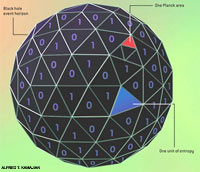
The Entropy of a Black Hole
The Entropy of a Black Hole is proportional to the area of its event horizon, the surface within which even light cannot escape the gravity of the hole. Specifically, a hole with a horizon spanning A Planck areas has A/4 units of entropy. (The Planck area, approximately 10-66 square centimeter, is the fundamental quantum unit of area determined by the strength of gravity, the speed of light and the size of quanta.) Considered as information, it is as if the entropy were written on the event horizon, with each bit (each digital 1 or 0) corresponding to four Planck areas.
A Tale of Two Entropies
Formal information theory originated in seminal 1948 papers by American applied mathematician Claude E. Shannon, who introduced today's most widely used measure of information content: entropy. Entropy had long been a central concept of thermodynamics, the branch of physics dealing with heat. Thermodynamic entropy is popularly described as the disorder in a physical system. In 1877 Austrian physicist Ludwig Boltzmann characterized it more precisely in terms of the number of distinct microscopic states that the particles composing a chunk of matter could be in while still looking like the same macroscopic chunk of matter. For example, for the air in the room around you, one would count all the ways that the individual gas molecules could be distributed in the room and all the ways they could be moving.
When Shannon cast about for a way to quantify the information contained in, say, a message, he was led by logic to a formula with the same form as Boltzmann's. The Shannon entropy of a message is the number of binary digits, or bits, needed to encode it. Shannon's entropy does not enlighten us about the value of information, which is highly dependent on context. Yet as an objective measure of quantity of information, it has been enormously useful in science and technology. For instance, the design of every modern communications device--from cellular phones to modems to compact-disc players--relies on Shannon entropy.
Thermodynamic entropy and Shannon entropy are conceptually equivalent: the number of arrangements that are counted by Boltzmann entropy reflects the amount of Shannon information one would need to implement any particular arrangement. The two entropies have two salient differences, though. First, the thermodynamic entropy used by a chemist or a refrigeration engineer is expressed in units of energy divided by temperature, whereas the Shannon entropy used by a communications engineer is in bits, essentially dimensionless. That difference is merely a matter of convention.
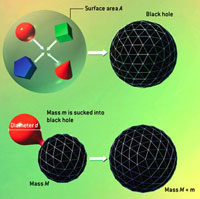
Limits of Functional Density
The thermodynamics of black holes allows one to deduce limits on the density of entropy or information in various circumstances. The holographic bound defines how much information can be contained in a specified region of space. It can be derived by considering a roughly spherical distribution of matter that is contained within a surface of area A. The matter is induced to collapse to form a black hole (a). The black hole's area must be smaller than A, so its entropy must be less than A/4 [see illustration]. Because entropy cannot decrease, one infers that the original distribution of matter also must carry less than A/4 units of entropy or information. This result--that the maximum information content of a region of space is fixed by its area--defies the commonsense expectation that the capacity of a region should depend on its volume.
The universal entropy bound defines how much information can be carried by a mass m of diameter d. It is derived by imagining that a capsule of matter is engulfed by a black hole not much wider than it (b). The increase in the black hole's size places a limit on how much entropy the capsule could have contained. This limit is tighter than the holographic bound, except when the capsule is almost as dense as a black hole (in which case the two bounds are equivalent).
The holographic and universal information bounds are far beyond the data storage capacities of any current technology, and they greatly exceed the density of information on chromosomes and the thermodynamic entropy of water (c).
Even when reduced to common units, however, typical values of the two entropies differ vastly in magnitude. A silicon microchip carrying a gigabyte of data, for instance, has a Shannon entropy of about 1010 bits (one byte is eight bits), tremendously smaller than the chip's thermodynamic entropy, which is about 1023 bits at room temperature. This discrepancy occurs because the entropies are computed for different degrees of freedom. A degree of freedom is any quantity that can vary, such as a coordinate specifying a particle's location or one component of its velocity.
The Shannon entropy of the chip cares only about the overall state of each tiny transistor etched in the silicon crystal--the transistor is on or off; it is a 0 or a 1--a single binary degree of freedom. Thermodynamic entropy, in contrast, depends on the states of all the billions of atoms (and their roaming electrons) that make up each transistor. As miniaturization brings closer the day when each atom will store one bit of information for us, the useful Shannon entropy of the state-of-the-art microchip will edge closer in magnitude to its material's thermodynamic entropy. When the two entropies are calculated for the same degrees of freedom, they are equal.
What are the ultimate degrees of freedom? Atoms, after all, are made of electrons and nuclei, nuclei are agglomerations of protons and neutrons, and those in turn are composed of quarks. Many physicists today consider electrons and quarks to be excitations of superstrings, which they hypothesize to be the most fundamental entities. But the vicissitudes of a century of revelations in physics warn us not to be dogmatic. There could be more levels of structure in our universe than are dreamt of in today's physics.
One cannot calculate the ultimate information capacity of a chunk of matter or, equivalently, its true thermodynamic entropy, without knowing the nature of the ultimate constituents of matter or of the deepest level of structure, which I shall refer to as level X. (This ambiguity causes no problems in analyzing practical thermodynamics, such as that of car engines, for example, because the quarks within the atoms can be ignored--they do not change their states under the relatively benign conditions in the engine.) Given the dizzying progress in miniaturization, one can playfully contemplate a day when quarks will serve to store information, one bit apiece perhaps. How much information would then fit into our one-centimeter cube? And how much if we harness superstrings or even deeper, yet undreamt of levels? Surprisingly, developments in gravitation physics in the past three decades have supplied some clear answers to what seem to be elusive questions.

The information content of a pile of computer chips increases in proportion with the number of chips or, equivalently, the volume they occupy. That simple rule must break down for a large enough pile of chips because eventually the information would exceed the holographic bound, which depends on the surface area, not the volume. The "breakdown" occurs when the immense pile of chips collapses to form a black hole. Black Hole Thermodynamics
A central player in these developments is the black hole. Black holes are a consequence of general relativity, Albert Einstein's 1915 geometric theory of gravitation. In this theory, gravitation arises from the curvature of spacetime, which makes objects move as if they were pulled by a force. Conversely, the curvature is caused by the presence of matter and energy. According to Einstein's equations, a sufficiently dense concentration of matter or energy will curve spacetime so extremely that it rends, forming a black hole. The laws of relativity forbid anything that went into a black hole from coming out again, at least within the classical (nonquantum) description of the physics. The point of no return, called the event horizon of the black hole, is of crucial importance. In the simplest case, the horizon is a sphere, whose surface area is larger for more massive black holes.
It is impossible to determine what is inside a black hole. No detailed information can emerge across the horizon and escape into the outside world. In disappearing forever into a black hole, however, a piece of matter does leave some traces. Its energy (we count any mass as energy in accordance with Einstein's E = mc2) is permanently reflected in an increment in the black hole's mass. If the matter is captured while circling the hole, its associated angular momentum is added to the black hole's angular momentum. Both the mass and angular momentum of a black hole are measurable from their effects on spacetime around the hole. In this way, the laws of conservation of energy and angular momentum are upheld by black holes. Another fundamental law, the second law of thermodynamics, appears to be violated.
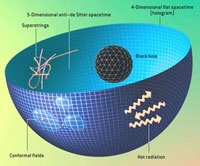
Holographic Space-Time
Two universes of different dimension and obeying disparate physical laws are rendered completely equivalent by the holographic principle. Theorists have demonstrated this principle mathematically for a specific type of five-dimensional spacetime ("antiÐde Sitter") and its four-dimensional boundary. In effect, the 5-D universe is recorded like a hologram on the 4-D surface at its periphery. Superstring theory rules in the 5-D spacetime, but a so-called conformal field theory of point particles operates on the 4-D hologram. A black hole in the 5-D spacetime is equivalent to hot radiation on the hologram--for example, the hole and the radiation have the same entropy even though the physical origin of the entropy is completely different for each case. Although these two descriptions of the universe seem utterly unalike, no experiment could distinguish between them, even in principle.
The second law of thermodynamics summarizes the familiar observation that most processes in nature are irreversible: a teacup falls from the table and shatters, but no one has ever seen shards jump up of their own accord and assemble into a teacup. The second law of thermodynamics forbids such inverse processes. It states that the entropy of an isolated physical system can never decrease; at best, entropy remains constant, and usually it increases. This law is central to physical chemistry and engineering; it is arguably the physical law with the greatest impact outside physics.
As first emphasized by Wheeler, when matter disappears into a black hole, its entropy is gone for good, and the second law seems to be transcended, made irrelevant. A clue to resolving this puzzle came in 1970, when Demetrious Christodoulou, then a graduate student of Wheeler's at Princeton, and Stephen W. Hawking of the University of Cambridge independently proved that in various processes, such as black hole mergers, the total area of the event horizons never decreases. The analogy with the tendency of entropy to increase led me to propose in 1972 that a black hole has entropy proportional to the area of its horizon. I conjectured that when matter falls into a black hole, the increase in black hole entropy always compensates or overcompensates for the "lost" entropy of the matter. More generally, the sum of black hole entropies and the ordinary entropy outside the black holes cannot decrease. This is the generalized second law--GSL for short.

Our innate perception that the world is three-dimensional could be an extraordinary illusion.
Hawking's radiation process allowed him to determine the proportionality constant between black hole entropy and horizon area: black hole entropy is precisely one quarter of the event horizon's area measured in Planck areas. (The Planck length, about 10-33 centimeter, is the fundamental length scale related to gravity and quantum mechanics. The Planck area is its square.) Even in thermodynamic terms, this is a vast quantity of entropy. The entropy of a black hole one centimeter in diameter would be about 1066 bits, roughly equal to the thermodynamic entropy of a cube of water 10 billion kilometers on a side.
The World as a Hologram
The GSL allows us to set bounds on the information capacity of any isolated physical system, limits that refer to the information at all levels of structure down to level X. In 1980 I began studying the first such bound, called the universal entropy bound, which limits how much entropy can be carried by a specified mass of a specified size [see box on opposite page]. A related idea, the holographic bound, was devised in 1995 by Leonard Susskind of Stanford University. It limits how much entropy can be contained in matter and energy occupying a specified volume of space.
In his work on the holographic bound, Susskind considered any approximately spherical isolated mass that is not itself a black hole and that fits inside a closed surface of area A. If the mass can collapse to a black hole, that hole will end up with a horizon area smaller than A. The black hole entropy is therefore smaller than A/4. According to the GSL, the entropy of the system cannot decrease, so the mass's original entropy cannot have been bigger than A/4. It follows that the entropy of an isolated physical system with boundary area A is necessarily less than A/4. What if the mass does not spontaneously collapse? In 2000 I showed that a tiny black hole can be used to convert the system to a black hole not much different from the one in Susskind's argument. The bound is therefore independent of the constitution of the system or of the nature of level X. It just depends on the GSL.
We can now answer some of those elusive questions about the ultimate limits of information storage. A device measuring a centimeter across could in principle hold up to 1066 bits--a mind-boggling amount. The visible universe contains at least 10100 bits of entropy, which could in principle be packed inside a sphere a tenth of a light-year across. Estimating the entropy of the universe is a difficult problem, however, and much larger numbers, requiring a sphere almost as big as the universe itself, are entirely plausible.
But it is another aspect of the holographic bound that is truly astonishing. Namely, that the maximum possible entropy depends on the boundary area instead of the volume. Imagine that we are piling up computer memory chips in a big heap. The number of transistors--the total data storage capacity--increases with the volume of the heap. So, too, does the total thermodynamic entropy of all the chips. Remarkably, though, the theoretical ultimate information capacity of the space occupied by the heap increases only with the surface area. Because volume increases more rapidly than surface area, at some point the entropy of all the chips would exceed the holographic bound. It would seem that either the GSL or our commonsense ideas of entropy and information capacity must fail. In fact, what fails is the pile itself: it would collapse under its own gravity and form a black hole before that impasse was reached. Thereafter each additional memory chip would increase the mass and surface area of the black hole in a way that would continue to preserve the GSL.
This surprising result--that information capacity depends on surface area--has a natural explanation if the holographic principle (proposed in 1993 by Nobelist Gerard 't Hooft of the University of Utrecht in the Netherlands and elaborated by Susskind) is true. In the everyday world, a hologram is a special kind of photograph that generates a full three-dimensional image when it is illuminated in the right manner. All the information describing the 3-D scene is encoded into the pattern of light and dark areas on the two-dimensional piece of film, ready to be regenerated. The holographic principle contends that an analogue of this visual magic applies to the full physical description of any system occupying a 3-D region: it proposes that another physical theory defined only on the 2-D boundary of the region completely describes the 3-D physics. If a 3-D system can be fully described by a physical theory operating solely on its 2-D boundary, one would expect the information content of the system not to exceed that of the description on the boundary.
A Universe Painted on Its Boundary
Can we apply the holographic principle to the universe at large? The real universe is a 4-D system: it has volume and extends in time. If the physics of our universe is holographic, there would be an alternative set of physical laws, operating on a 3-D boundary of spacetime somewhere, that would be equivalent to our known 4-D physics. We do not yet know of any such 3-D theory that works in that way. Indeed, what surface should we use as the boundary of the universe? One step toward realizing these ideas is to study models that are simpler than our real universe.
A class of concrete examples of the holographic principle at work involves so-called anti-de Sitter spacetimes. The original de Sitter spacetime is a model universe first obtained by Dutch astronomer Willem de Sitter in 1917 as a solution of Einstein's equations, including the repulsive force known as the cosmological constant. De Sitter's spacetime is empty, expands at an accelerating rate and is very highly symmetrical. In 1997 astronomers studying distant supernova explosions concluded that our universe now expands in an accelerated fashion and will probably become increasingly like a de Sitter spacetime in the future. Now, if the repulsion in Einstein's equations is changed to attraction, de Sitter's solution turns into the anti-de Sitter spacetime, which has equally as much symmetry. More important for the holographic concept, it possesses a boundary, which is located "at infinity" and is a lot like our everyday spacetime.
Using anti-de Sitter spacetime, theorists have devised a concrete example of the holographic principle at work: a universe described by superstring theory functioning in an anti-de Sitter spacetime is completely equivalent to a quantum field theory operating on the boundary of that spacetime [see box above]. Thus, the full majesty of superstring theory in an anti-de Sitter universe is painted on the boundary of the universe. Juan Maldacena, then at Harvard University, first conjectured such a relation in 1997 for the 5-D anti-de Sitter case, and it was later confirmed for many situations by Edward Witten of the Institute for Advanced Study in Princeton, N.J., and Steven S. Gubser, Igor R. Klebanov and Alexander M. Polyakov of Princeton University. Examples of this holographic correspondence are now known for spacetimes with a variety of dimensions.
This result means that two ostensibly very different theories--not even acting in spaces of the same dimension--are equivalent. Creatures living in one of these universes would be incapable of determining if they inhabited a 5-D universe described by string theory or a 4-D one described by a quantum field theory of point particles. (Of course, the structures of their brains might give them an overwhelming "commonsense" prejudice in favor of one description or another, in just the way that our brains construct an innate perception that our universe has three spatial dimensions; see the illustration on the opposite page.)
The holographic equivalence can allow a difficult calculation in the 4-D boundary spacetime, such as the behavior of quarks and gluons, to be traded for another, easier calculation in the highly symmetric, 5-D anti-de Sitter spacetime. The correspondence works the other way, too. Witten has shown that a black hole in anti-de Sitter spacetime corresponds to hot radiation in the alternative physics operating on the bounding spacetime. The entropy of the hole--a deeply mysterious concept--equals the radiation's entropy, which is quite mundane.
The Expanding Universe
Highly symmetric and empty, the 5-D anti-de Sitter universe is hardly like our universe existing in 4-D, filled with matter and radiation, and riddled with violent events. Even if we approximate our real universe with one that has matter and radiation spread uniformly throughout, we get not an anti-de Sitter universe but rather a "Friedmann-Robertson-Walker" universe. Most cosmologists today concur that our universe resembles an FRW universe, one that is infinite, has no boundary and will go on expanding ad infinitum.
Does such a universe conform to the holographic principle or the holographic bound? Susskind's argument based on collapse to a black hole is of no help here. Indeed, the holographic bound deduced from black holes must break down in a uniform expanding universe. The entropy of a region uniformly filled with matter and radiation is truly proportional to its volume. A sufficiently large region will therefore violate the holographic bound.
In 1999 Raphael Bousso, then at Stanford, proposed a modified holographic bound, which has since been found to work even in situations where the bounds we discussed earlier cannot be applied. Bousso's formulation starts with any suitable 2-D surface; it may be closed like a sphere or open like a sheet of paper. One then imagines a brief burst of light issuing simultaneously and perpendicularly from all over one side of the surface. The only demand is that the imaginary light rays are converging to start with. Light emitted from the inner surface of a spherical shell, for instance, satisfies that requirement. One then considers the entropy of the matter and radiation that these imaginary rays traverse, up to the points where they start crossing. Bousso conjectured that this entropy cannot exceed the entropy represented by the initial surface--one quarter of its area, measured in Planck areas. This is a different way of tallying up the entropy than that used in the original holographic bound. Bousso's bound refers not to the entropy of a region at one time but rather to the sum of entropies of locales at a variety of times: those that are "illuminated" by the light burst from the surface.
Bousso's bound subsumes other entropy bounds while avoiding their limitations. Both the universal entropy bound and the 't Hooft-Susskind form of the holographic bound can be deduced from Bousso's for any isolated system that is not evolving rapidly and whose gravitational field is not strong. When these conditions are overstepped--as for a collapsing sphere of matter already inside a black hole--these bounds eventually fail, whereas Bousso's bound continues to hold. Bousso has also shown that his strategy can be used to locate the 2-D surfaces on which holograms of the world can be set up.
Researchers have proposed many other entropy bounds. The proliferation of variations on the holographic motif makes it clear that the subject has not yet reached the status of physical law. But although the holographic way of thinking is not yet fully understood, it seems to be here to stay. And with it comes a realization that the fundamental belief, prevalent for 50 years, that field theory is the ultimate language of physics must give way. Fields, such as the electromagnetic field, vary continuously from point to point, and they thereby describe an infinity of degrees of freedom. Superstring theory also embraces an infinite number of degrees of freedom. Holography restricts the number of degrees of freedom that can be present inside a bounding surface to a finite number; field theory with its infinity cannot be the final story. Furthermore, even if the infinity is tamed, the mysterious dependence of information on surface area must be somehow accommodated.
Holography may be a guide to a better theory. What is the fundamental theory like? The chain of reasoning involving holography suggests to some, notably Lee Smolin of the Perimeter Institute for Theoretical Physics in Waterloo, that such a final theory must be concerned not with fields, not even with spacetime, but rather with information exchange among physical processes. If so, the vision of information as the stuff the world is made of will have found a worthy embodiment.
Jacob D. Bekenstein has contributed to the foundation of black hole thermodynamics and to other aspects of the connections between information and gravitation. He is Polak Professor of Theoretical Physics at the Hebrew University of Jerusalem, a member of the Israel Academy of Sciences and Humanities, and a recipient of the Rothschild Prize. Bekenstein dedicates this article to John Archibald Wheeler (his Ph.D. supervisor 30 years ago). Wheeler belongs to the third generation of Ludwig Boltzmann's students: Wheeler's Ph.D. adviser, Karl Herzfeld, was a student of Boltzmann's student Friedrich Hasenšhrl.
In the 1950s, while conducting research into the beliefs of LSD as a psychotherapeutic tool, Grof had one female patient who suddenly became convinced she had assumed the identity of a female of a species of prehistoric reptile. During the course of her hallucination, she not only gave a richly detailed description of what it felt like to be encapsulated in such a form, but noted that the portion of the male of the species's anatomy was a patch of colored scales on the side of its head.
What was startling to Grof was that although the woman had no prior knowledge about such things, a conversation with a zoologist later confirmed that in certain species of reptiles colored areas on the head do indeed play an important role as triggers of sexual arousal.
The woman's experience was not unique. During the course of his research, Grof encountered examples of patients regressing and identifying with virtually every species on the evolutionary tree (research findings which helped influence the man-into-ape scene in the movie Altered States). Moreover, he found that such experiences frequently contained obscure zoological details which turned out to be accurate.
Regressions into the animal kingdom were not the only puzzling psychological phenomena Grof encountered. He also had patients who appeared to tap into some sort of collective or racial unconscious.
- Individuals with little or no education suddenly gave detailed descriptions of Zoroastrian funerary practices and scenes from Hindu mythology. In other categories of experience, individuals gave persuasive accounts of out-of-body journeys, of precognitive glimpses of the future, of regressions into apparent past-life incarnations.
In later research, Grof found the same range of phenomena manifested in therapy sessions which did not involve the use of drugs. Because the common element in such experiences appeared to be the transcending of an individual's consciousness beyond the usual boundaries of ego and/or limitations of space and time, Grof called such manifestations "transpersonal experiences", and in the late '60s he helped found a branch of psychology called "transpersonal psychology" devoted entirely to their study.
Although Grof's newly founded Association of Transpersonal Psychology garnered a rapidly growing group of like-minded professionals and has become a respected branch of psychology, for years neither Grof or any of his colleagues were able to offer a mechanism for explaining the bizarre psychological phenomena they were witnessing. But that has changed with the advent of the holographic paradigm.
As Grof recently noted, if the mind is actually part of a continuum, a labyrinth that is connected not only to every other mind that exists or has existed, but to every atom, organism, and region in the vastness of space and time itself, the fact that it is able to occasionally make forays into the labyrinth and have transpersonal experiences no longer seems so strange.
The holographic prardigm also has implications for so-called hard sciences like biology. Keith Floyd, a psychologist at Virginia Intermont College, has pointed out that if the concreteness of reality is but a holographic illusion, it would no longer be true to say the brain produces consciousness. Rather, it is consciousness that creates the appearance of the brain -- as well as the body and everything else around us we interpret as physical.
Such a turnabout in the way we view biological structures has caused researchers to point out that medicine and our understanding of the healing process could also be transformed by the holographic paradigm. If the apparent physical structure of the body is but a holographic projection of consciousness, it becomes clear that each of us is much more responsible for our health than current medical wisdom allows. What we now view as miraculous remissions of disease may actually be due to changes in consciousness which in turn effect changes in the hologram of the body. Similarly, controversial new healing techniques such as visualization may work so well because in the holographic domain of thought images are ultimately as real as "reality".
Even visions and experiences involving "non-ordinary" reality become explainable under the holographic paradigm. In his book "Gifts of Unknown Things," biologist Lyall Watson discribes his encounter with an Indonesian shaman woman who, by performing a ritual dance, was able to make an entire grove of trees instantly vanish into thin air. Watson relates that as he and another astonished onlooker continued to watch the woman, she caused the trees to reappear, then "click" off again and on again several times in succession.
Although current scientific understanding is incapable of explaining such events, experiences like this become more tenable if "hard" reality is only a holographic projection. Perhaps we agree on what is "there" or "not there" because what we call consensus reality is formulated and ratified at the level of the human unconscious at which all minds are infinitely interconnected.
If this is true, it is the most profound implication of the holographic paradigm of all, for it means that experiences such as Watson's are not commonplace only because we have not programmed our minds with the beliefs that would make them so. In a holographic universe there are no limits to the extent to which we can alter the fabric of reality.
What we perceive as reality is only a canvas waiting for us to draw upon it any picture we want. Anything is possible, from bending spoons with the power of the mind to the phantasmagoric events experienced by Castaneda during his encounters with the Yaqui brujo don Juan, for magic is our birthright, no more or less miraculous than our ability to compute the reality we want when we are in our dreams.
Indeed, even our most fundamental notions about reality become suspect, for in a holographic universe, as Pribram has pointed out, even random events would have to be seen as based on holographic principles and therefore determined. Synchronicities or meaningful coincidences suddenly makes sense, and everything in reality would have to be seen as a metaphor, for even the most haphazard events would express some underlying symmetry.
Whether Bohm and Pribram's holographic paradigm becomes accepted in science or dies an ignoble death remains to be seen, but it is safe to say that it has already had an influence on the thinking of many scientists. And even if it is found that the holographic model does not provide the best explanation for the instantaneous communications that seem to be passing back and forth between subatomic particles, at the very least, as noted by Basil Hiley, a physicist at Birbeck College in London, Aspect's findings "indicate that we must be prepared to consider radically new views of reality".
The Holographic Universe - Crystalinks

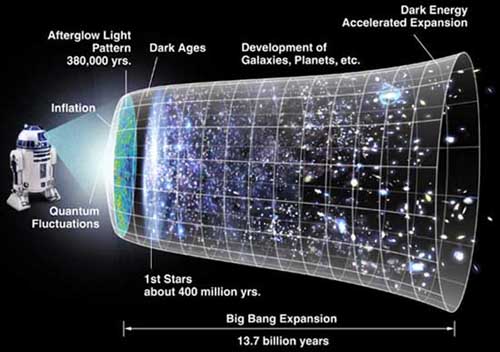

Comments
I don't pretend to understand
I don't pretend to understand all of this but this is so interesting (The Matrix is my most fave movie of all time!)... Thanks for sharing. :)